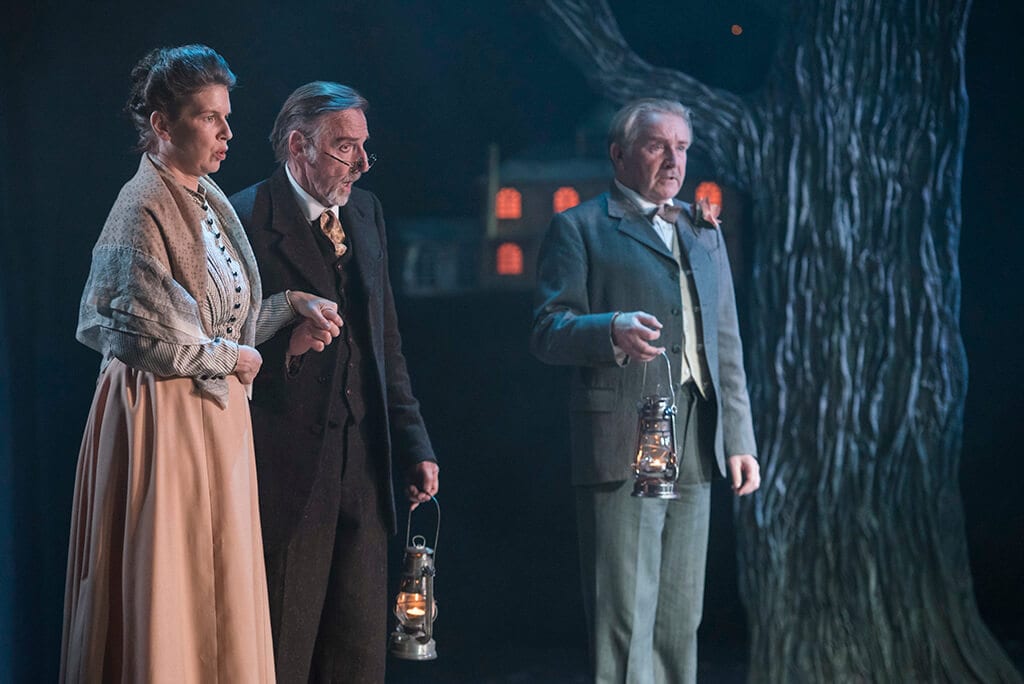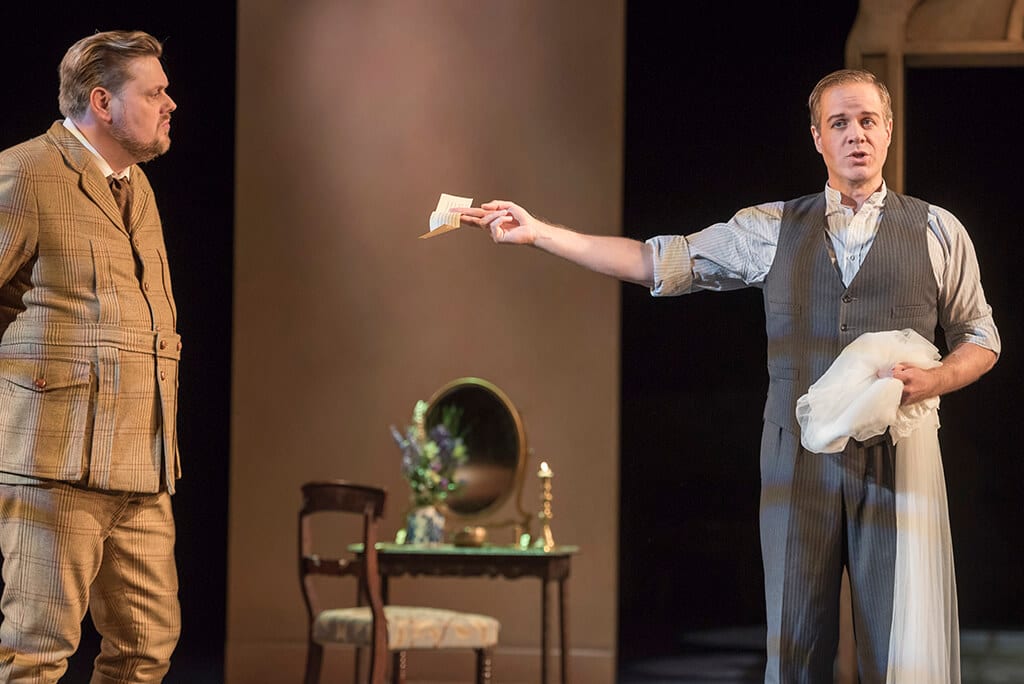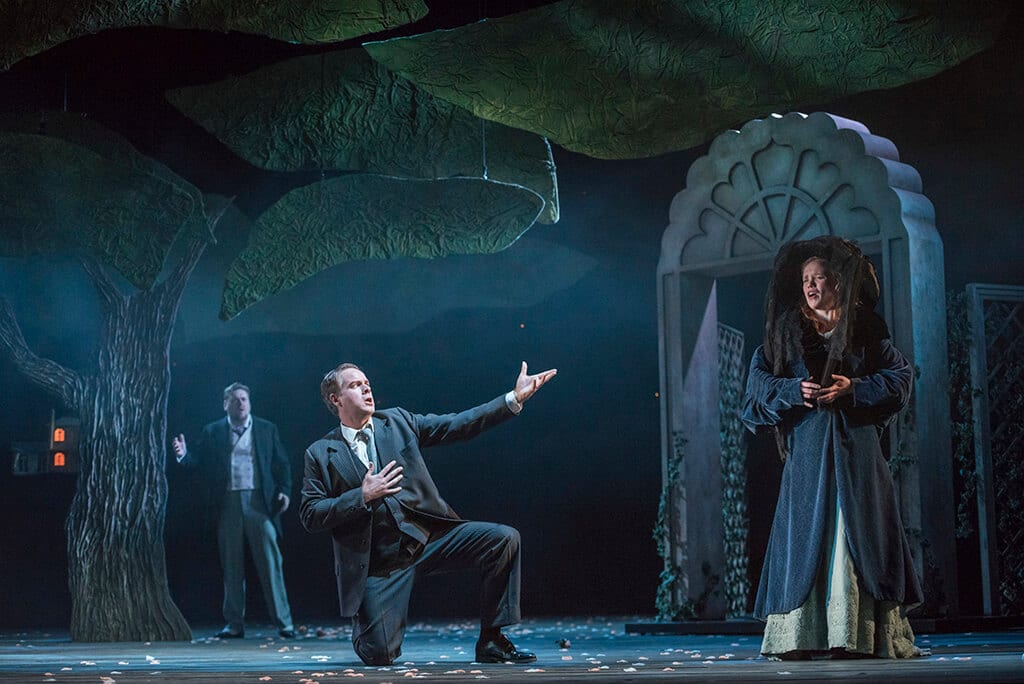You do not go to Longborough for hugely glamorous productions. A bit like Bayreuth after WWII, the approach is highly intelligent but quite minimalist. The first half of this new Marriage of Figaro is almost played on a bare stage; the second half has a bit more furniture and suggestions of a set. But at all times you know exactly where you are and the bits of scenery or furniture are highly evocative and useful.
And yes, I did like the country house appearing in the distance in the last scene and the way the set suggested the large grounds of the Count’s Domain.
The costumes suggest the period of World War I, highly topical as we commemorate the centenary of the Battle of the Somme. If the plight of Cherubino being sent to the Count’s regiment has darker echoes because of that, suggesting the dangers of military slaughter rather than the glories of heroic battle, the irony of this is entirely consistent with a production that places at its centre, I believe, a strong sense of the struggles women have in a patriarchal world that is about to be blown apart. I could not avoid also thinking that this production had many echoes of the film The Rules of the Game (La Règle du Jeu) by Jean Renoir that is also set just before a major war. One is watching a kind of comedy of manners but also a comment on the society in which the Count is a figure emblematic of its moral callousness and blinkered self-righteousness that have a devastating impact.
What you do go to Longborough for is a really interesting, consistent production that makes a coherent case for the work itself both musically and dramatically. This Figaro production does that. This is a strong, cogent production – and, of course, it works not only because of the fine, controlled conducting of Robert Houssart, and the production concept by director Thomas Guthrie, but also because of a superb and delightful cast of singers who also know how to act. The Countess of Susanna Fairairn is a case in point. Her increasing distrust of her husband, her pained inability to stop loving him though she can see through him, her sense of frustration and powerlessness are all conveyed in her voice, her facial expressions and her physicality. From the moment she walks onto the stage and starts singing Porgi Amor, her pain is evident; and we are on her side. She is a superbly poignant Countess and her relationship to Susanna is very believably conveyed – both her reliance upon her servant and her distress at having to rely upon a servant. As for her relationship with Anna Harvey’s rangy, lanky, and believably boyish Cherubino, it is pretty clear that they are going to have an affair someday soon and this led me to remember and think about the neglected third play of the Beaumarchais trilogy, The Guilty Mother (La Mère Coupable). One thing I liked a lot about this Figaro was that I felt everyone had actually studied the play and knew the pre-Revolutionary context.
The Count of Benjamin Bevan conveys his sense of privilege, her blinkered self-righteousness and the glimmers of his having enough perception for the occasional moment not so much of guilt as of embarrassment when confronted with people showing they know what he is. His interest in hunting and carrying around of that gun seems to me to be one of the references to the Renoir movie. He has exactly the right vocal heft for this role. Grant Doyle’s cheeky Figaro is a gem – he seems to embody the character perfectly. He is still the Figaro of The Barber of Seville but he has grown in stature, become more angry, has more edge. And he is superlatively in love! Like Benjamin Bevan, Grant Doyle’s arias were impressively done?
And who would not believe he was besotted with Susanna? The role was taken by Beate Mordal and she has everything that it requires. She is young, attractive, pert and cheeky; her acting is varied and nuanced; she was breathtaking throughout the evening and especially in her aria Deh, vieni non tardar . She was completely captivating. Her moments in the comic sequence where Figaro discovers his parentage added wonderfully to the comedy; and her duet with the Countess in the third scene was simply stunning.
There was not a weak link in the cast – and I have not even mentioned Wendy Dawn Thompson’s touching and fierce Marcellina or Lucy Knight’s Barbarina or the comic intensity of Eric Roberts; and I wish I had more room and time because it seemed to me that more nuances of the work were explored and displayed than you usually get.




